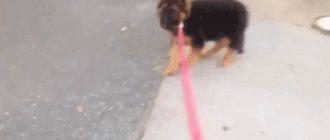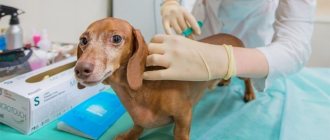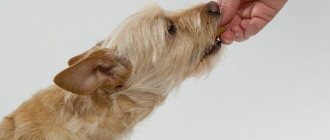If you've just adopted a puppy into your home, you might want to immediately take him out for a walk, show him around and let him play with other dogs, but this is dangerous because without the protection of vaccines, he could get sick.
In other cases, there are owners who are extremely careful to keep the puppy at home, taking him out into the world until the vaccination period is over, and this is also not entirely positive, since it harms the socialization of the animal. So, the question that inevitably comes to our minds is: “Is it possible to walk a puppy without vaccinations?” In this article we will give you some tips.
Walking a puppy without vaccinations
It was said a long time ago that it was a bad idea to take out puppies when they had not completed their vaccination schedule, that is, until they had received the latest vaccine they should not go out for walks because they were not protected from diseases and could become infected. This is partly true, since without the protection that vaccines offer, they can contract some diseases, but this leaves aside a fundamental fact: the importance of a puppy's socialization stage .
© shutterstock
In general, the socialization stage lasts from one month to three months of a dog's life, so it largely coincides with the period in which the animal receives vaccines. During this period, puppies typically learn the behavior of canine species and establish relationships with their environment. That is, he begins to understand the world around him and the people, objects and animals that are in it.
Poor socialization can cause, among other things, fears and phobias. This is because, as already stated, during the socialization stage, puppies begin to exhibit things such as cars, motorcycles, other dogs, children, people of different races and the like. Thus, it is very convenient for them to assimilate them then, so that later, as an adult, they do not recognize them as something strange and harmful to fear. It is therefore beneficial to go outside during this period for the animal's future mental health, and the fact that a dog has not completed its vaccination schedule does not mean that it should become a "house dog" isolated from the world. Thus, we see how you don’t need to wait for a specific vaccine to start taking your puppy outside. Of course, extreme precautions must be taken to prevent them from contracting diseases that can be fatal, such as canine parvovirus.
Answer
As a rule, a newborn puppy no more than a week old is protected by the mother’s immunity, transmitted through milk. The baby is saturated with protective necessary antibodies. When a small dog is separated from its mother, the immune system gradually begins to weaken, and the necessary means of protection are applied in the form of vaccination.
When deciding to get a small dog at the age of 1-1.5 months, you must approach care and education with vigilance and caution in order to completely eliminate the risk of possible diseases.
It is strongly recommended to limit the puppy's contact with strangers and animals as much as possible until the necessary vaccinations have been received. Fourteen days must pass after vaccination; during this period, the dog’s immunity begins to form, which means that the pet is more vulnerable to diseases.
Vaccination is considered an important procedure that significantly reduces the risk of infection and disease. Even if a puppy unexpectedly picks up an infection, the disease often proceeds without possible complications. Vaccinations reliably protect against infectious diseases: canine distemper, parvovirus enteritis, adenoviral hepatitis, rhinotracheitis, rabies, leptospirosis, etc.
Types of vaccination:
- Mono-vaccines are products designed against a single disease.
- Polyvaccines are intended for several types of diseases.
Types of vaccines for puppies have been invented:
- Vaccines created exclusively from killed microorganisms. Compared to live vaccines, the product does not cause disease even in weakened dogs.
- Live vaccines. The drugs are obtained from weakened strains of pathogens. Live vaccines can cause a mild infection, which helps the animal develop strong immunity.
How to take a puppy for a walk without vaccination?
As we have already seen, isolating the dog at this stage is not positive, and it is extremely dangerous to allow it to wander uncontrollably, so it is advisable to choose a middle ground. That is, the answer to the question whether it is possible to breed a puppy without vaccinations is yes, but carefully .
© shutterstock
It may then be advisable to avoid exposing your puppy to other dogs unless you are completely sure that they are healthy and properly vaccinated. Also, the baby should not come into contact with the urine or stool of other animals. To do this, you can do short intermediate walks, since it is not necessary to do this every day, two or three times a week is enough. During these walks with an unvaccinated puppy, you should avoid areas that could become a source of illness, such as puddles, areas of standing water or mud, and corners or areas where other dogs may have urinated or defecated. In short, just let him wander around and sniff places that seem clean.
On the other hand, even though there is no dirt in the area, it is recommended that you do not allow the animal to lick the floor or any other surface. You can also carry your puppy in your arms, although this should not be done excessively as it can cause the animal to become overly attached to its owner. In this sense, most pet accessory stores, and even on the Internet, sell backpacks of sorts in which the animal can be placed, which makes the task more comfortable.
There is also no need to lock the puppy in a room when we visit people and other dogs, or ask our friends or relatives not to come to our house, thinking that they might infect the puppy. Of course, we must always ensure that these animals are properly vaccinated and dewormed, and we must prohibit visitors from touching the puppy with dirty hands.
When is the first vaccination given?
The first vaccination for a puppy takes place at two months, before that it needs to be dewormed - 10-14 days in advance, while deworming tablets are given a second time after a certain time. It may seem to some that vaccination is a common procedure that animals tolerate easily and painlessly. There is some truth in this - the vaccine is administered quickly, the manipulation time does not exceed 30 minutes, however, due to the individual characteristics of the body, puppies react to it differently. For some dogs, after vaccination, everything goes well, for others, complications arise, which can be divided into two groups: local and general.
Local include lumps and bumps at the injection site. Usually the tumor resolves naturally after some time, but in some cases it can become inflamed and cause discomfort to the puppy.
Common complications are characterized by:
- general depressed state of the animal;
- soreness;
- increased temperature, sometimes even up to 40 degrees;
- allergic reactions (swelling, itching, anaphylactic shock).
Similar complications are observed during the first days after vaccination. If the painful condition does not go away, you should seek help from a veterinarian.
When can you go for a walk after the last vaccine?
Once the vaccination schedule is complete, the puppy can begin to go outside without restrictions, interact with other dogs, sniff, and discover new surroundings. Also, we can already begin to train him for this purpose, first teaching him to use a collar and a leash.
On the other hand, keep in mind that his education is not only based on socialization and proper walking, it is also important to work with him on bite inhibition, basic routines, coexistence rules, etc. to improve the bond between you and keep your puppy smart at all times. stimulated.
Preparing your pet for a visit
Certain rules must be followed before vaccination. Of course, the veterinarian will also examine your four-legged friend before administering the drug, but you also need to take a number of measures:
- Examine mucous membranes and regularly measure body temperature 5–7 days before vaccination.
- It is not recommended for the dog to eat food for at least 4 hours before vaccination, but the animal can drink.
- Treat your pet for parasites. Deworming medications are usually used 2-3 weeks before vaccination. Be careful when choosing a drug - if it needs to be applied twice, it is important to complete the treatment before visiting the veterinarian.
Veterinarians do not recommend taking dogs outside until the end of quarantine after the second (third) vaccine.
Why do you need to walk your puppy outdoors?
For full development, it is important to provide a healthy dog with active movement, and the street is perfect for this. In addition, during a walk, new smells and sounds are learned, which is also an important part of development. On the street, the puppy gets to know other animals, looks attentively, remembers their habits and learns to interact with them.
Dogs need walks in the fresh air
Being in the fresh air, the dog learns the rules of behavior. In this case, all responsibility lies with the owner, because the training of commands and the future behavior of the baby depend on him.
For pets, except decorative breeds, the street is a place where they can relieve their natural needs. To this end, the owner must teach the puppy to go to the toilet outside. If this is not done, then permanent puddles at home are guaranteed.
Having found out how many months you can walk with a puppy, you need to gradually begin to accustom your pet to going outside the apartment.
Important! Frequent walks with puppies and adult dogs are a must. Huskies, terriers, spaniels, jacks, corgis and labradors especially enjoy long walks. These breeds need space, so it is better to choose parks and forests for walking.
Points to consider while walking
A walk should bring joy to your pet. It is necessary to organize it competently so that it is exciting, active and, most importantly, safe.
There are a number of rules for walking that the owner should consider:
- You need to start walking gradually, and you need to find out from the veterinarian at what age you can walk your puppy so as not to catch an infection.
- It is recommended to go for a walk to a special dog park. If there is none, then you need to choose a secluded, quiet place and, most importantly, away from the road. For example, dachshund dogs especially enjoy walks near a pond.
- It is necessary to accustom your pet to the route gradually. So, for 3-4 weeks you need to walk the same road to the place of walking.
- The dog must be kept on a leash. You can let him off the leash, but only if the dog reacts calmly to people and other animals.
- To be able to redirect your pet’s attention, you should take toys that can captivate him when going for a walk.
- Gradually, the dog needs to be taught to follow commands. The best helpers in this case will be treats that you need to take for a walk.
- While walking, you need to make sure that the dog does not pick up food from the ground.
- Attempts at aggression towards other pets and people must be sharply suppressed.
- The dog should be prohibited from relieving itself at the entrance.
In winter, some breeds need special clothing
When going off the leash, the owner needs to be prepared for the fact that people around will be unhappy with this. This is a natural reaction, since many people are wary of dogs without a leash or muzzle. It is worth taking care of the safety of citizens: either walk the dog away from people, or put a muzzle and leash on it.
In general, properly organized walks for pets will bring joy to both the four-legged friend and his owner.
Inactivated or attenuated vaccines: what is the difference, which one to choose?
Attenuated vaccine. In this case, a small amount of live, weakened viruses is injected into the animal. Once in the blood, viruses begin to multiply, causing the formation of immunity to fight them. The puppy suffers from the disease, but in a weak form, immunity is developed quickly, after a week it is persistent and lasts up to three years!
Inactivated vaccine. This is a larger amount of the injected virus, it does not multiply, immunity is developed more slowly and lasts only a few months.
After what vaccination can you take your puppy for walks before? Theoretically, after attenuated, because immunity is developed within a week. But veterinarians recommend that in both cases it is better to wait the recommended time, and schedule walking only after quarantine after the 2nd vaccine.
Is quarantine mandatory?
If your dog is not vaccinated or quarantined before and after vaccinations, it can become infected with one of the following diseases:
- plague;
- parainfluenza;
- enteritis;
- rabies;
- leptospirosis;
- infectious hepatitis.
Whether to get the first two and subsequent vaccinations or not is up to you, but in Russia it is mandatory to vaccinate animals against rabies! If you do not comply with the recommended quarantine and walk before vaccinations or immediately after them, then there is a high probability that the animal will get sick. Of course, today veterinary medicine has stepped very far forward, but even if the dog does not die, during the illness he will be severely exhausted, and irreparable harm will be caused to the body.
Rules for walking a puppy
To prevent troubles from walking, there are several rules:
- in the first days, the walking route should not be changed so that the puppy can quickly get used to the street;
- do not feed the animal before a walk;
- time spent outside should be short, but you need to go for walks often so as not to overload the baby;
- do not walk in bad weather;
- contact with adult foreign dogs should be minimal to prevent injury and aggression from the adult dog.
A small puppy, like a small child, requires a lot of responsibility, love, care and attention. By following the recommendations of breeders and veterinarians, you can minimize the troubles that accompany an animal’s growing up, protecting it from injury and disease.











